Fort St. Vrain in Pictures: 1

What became the Fort St. Vrain Nuclear Generating Station began as a study almost two decades before the plant was completed and led to years of effort to construct a commercial high-temperature gas-cooled nuclear power plant. While the effort did not ultimately lead to a successfully competitive alternative to light water designs, it did add considerably to the knowledge and experience base of gas-cooled reactors specifically and nuclear power generally. We will chronicle the effort in images - mostly using those from an incredible press package in the author's collection. (Photos will enlarge when clicked.)
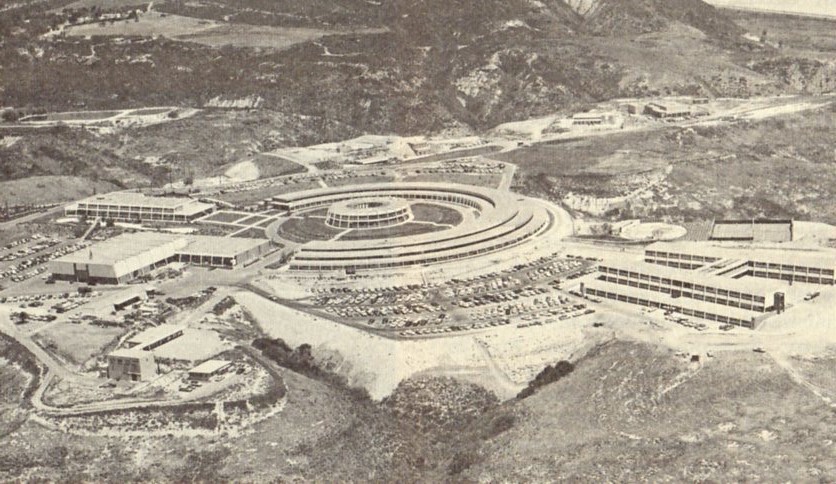
New headquarters for General Atomic under construction at Torrey Pines, California, late 1950's. See next photo for details. This company championed gas cooled reactors and, after several changes of ownership, still does today.
Public Service Company of Colorado (PSCo) - the company that would eventually own and operate the Fort St. Vrain Station - became involved with nuclear energy in 1954 when it and eight other utility and corporate partners formed the Rocky Mountain Nuclear Power Study Group for the purpose of determining approaches to utilize nuclear energy in the wake of the amendment to the Atomic Energy Act allowing private groups access to such technology.
PSCo became connected with the General Atomic Division of the General Dynamics Corporation just four years later in 1958 when it and seven utility companies formed the (separate) Rocky Mountain - Pacific Nuclear Power Study Group. This arrangement focused on the study of high temperature gas cooled reactors using a graphite moderator. In that same year, some of the members of this new group (including PSCo) joined a large 53-member group that also pushed for a gas-cooled reactor; this wider effort would lead to the construction of the Peach Bottom Atomic Power Station in Pennsylvania. Peach Bottom differed considerably from what later became Fort St. Vrain, but its construction and operation was pivotal to, and integral with, the path that led to Fort St. Vrain. Without going into detail on the Peach Bottom effort, it cannot be understated how important Peach Bottom was to PSCo's continuing effort. PSCo's effort was in fact contingent upon operational success of the Peach Bottom plant. Naturally, that held reactor vendor's (General Atomic) future in the field of gas-cooled reactors, in the balance as well.
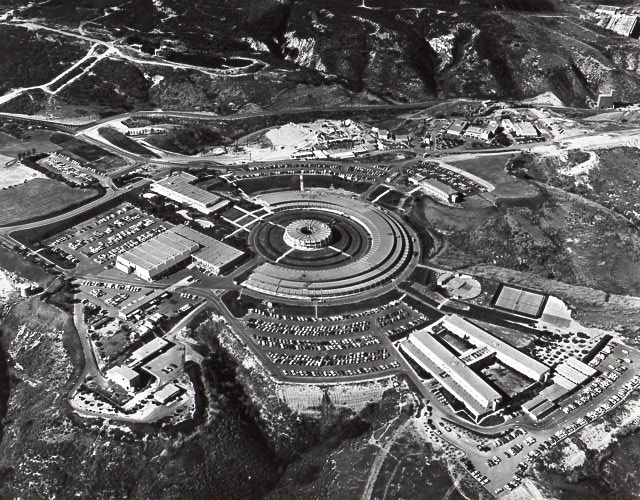
Headquarters of the General Atomic Division of General Dynamics was this impressive facility at Torrey Pines, California - the John Jay Hopkins Center for Pure and Applied Science, which was dedicated in 1959. At the left are offices and a high-bay building used for experiments, while at lower left is the fusion energy laboratory. At lower right is a technical office building; at the upper right are a critical test facility, a linear accelerator, the TRIGA training / research reactor center, a hot cell facility and a tower for testing reactor components. Upper far right top (just visible) is the nuclear fuel fabrication facility. Dominating the view are, at center, the library and technical information building and, surrounding it in a semicircle, a building housing 150 laboratories.
Following the launch of the project to build Peach Bottom the U.S. Atomic Energy Commission (AEC) promulgated a request for a follow-on plant which would be larger and hopefully much more like a competitive commercially viable design. While there were other proposals offered to the AEC (notably, one by Rochester Gas & Electric in New York) the AEC selected PSCo for the construction of a 330 MWe gas-cooled, graphite-moderated plant. The project to build this plant was announced to the public on March 13, 1965.
The project moved along at the rapid pace common to many of the early nuclear plants. On November 1, 1965, PSCo, AEC, and General Atomic signed a contract for the construction of the plant although a location had not yet been determined. However, on November 23, PSCo announced that it had selected a site in Weld County, Colorado, about four miles northwest of Platteville.
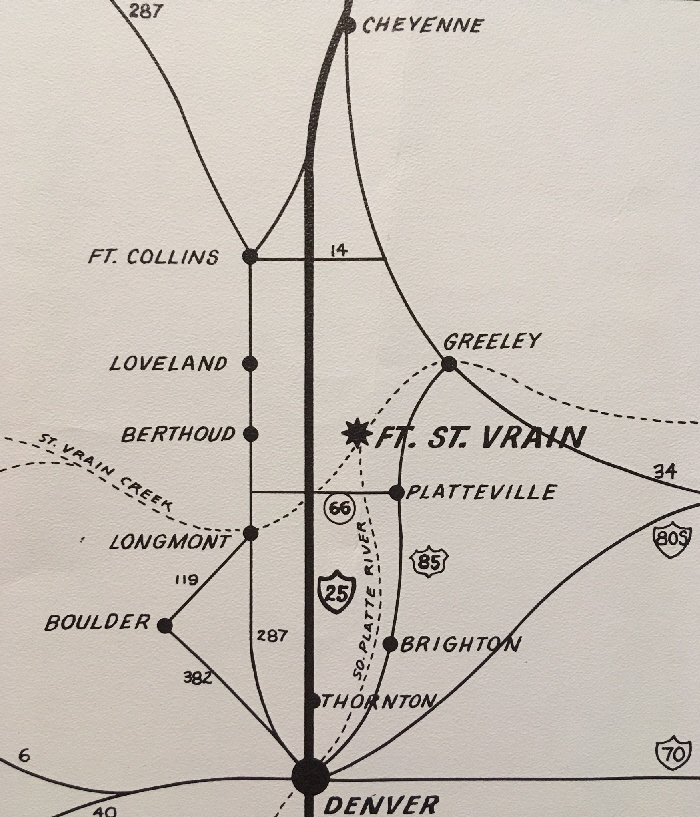
This map shows the selected location for PSCo's new nuclear plant, November 1965, at a location between Cheyenne and Denver and just to the northwest of Platteville, Co.
In January 1966, at the first meeting of the Platteville Improvement Association, PSCo announced that the new nuclear plant would be known as the Fort St. Vrain Nuclear Generating Station. The origin of the name is explained in a booklet published by PSCo and is reproduced here:
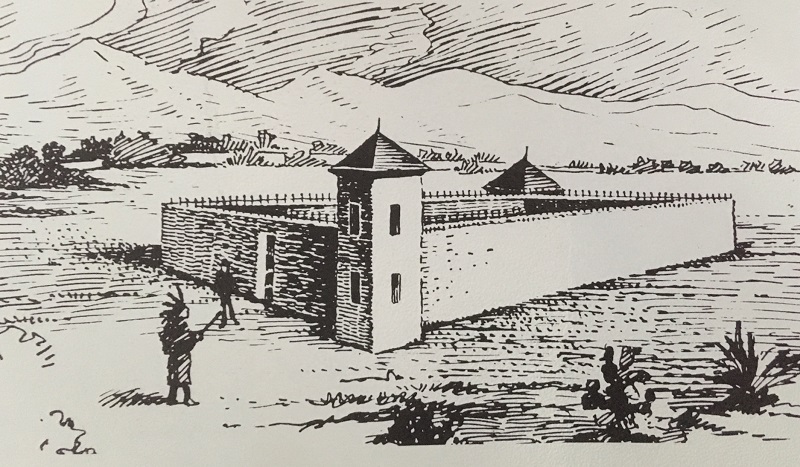
"How did Public Service Co. of Colorado happen to select 'Fort St. Vrain' as the name for Colorado's first nuclear electric generating station?
There really was a Fort St. Vrain, located about two miles northeast of the location of the power plant. The first Fort St. Vrain was built in 1837 by Ceran St. Vrain, a French trapper. It was one of several active trading posts in the area in those days.
When the fur trade was near collapse in 1844, Fort St. Vrain was abandoned, but sometime after 1846 it was reopened as a general store. It also served as the County Seat of Weld County when the Territory of Colorado was formed in 1861. A U.S. Post Office was located at the Fort until 1870, when it was moved to Platteville to be on a railroad line."

It is probably no accident that the Fort St. Vrain Public Information Center built across from the nuclear plant and the sketch of the original Fort appear so similar. This center still stands.
While critically important developmental testing was beginning at the now-completed Peach Bottom plant in Pennsylvania, design work went ahead on Fort St. Vrain. This new plant would be radically different, in that it would attempt to make the primary or Nuclear Steam Supply System (NSSS) of the plant more compact. To do this it would use a new fuel design and, for the first time in the United States, would employ a prestressed concrete containment vessel.

This sketch from a 1965 General Atomic report shows the planned layout of the plant, with the large concrete containment vessel enclosed in the tall structure and the turbine generator in the building to the right. This sketch only roughly represents the plant as built.
While low-power testing was underway at Peach Bottom, PSCo began construction of a small facility at its Valmont station to test helium circulators that would be used at the new nuclear plant. The company also built a 204 foot tall weather tower at the Fort St. Vrain site to gather weather data which would be used in its application to the AEC. On October 20, 1966, PSCo officially filed its application for a construction permit with the AEC. Not too long after that, in January 1967, Peach Bottom was able to generate electricity - a major accomplishment and a good sign for PSCo that its project would move along.
In June 1967, just as Peach Bottom reached its full-rated power on the grid, the planned Fort St. Vrain site was inspected by members of the Advisory Committee on Reactor Safeguards. This was a very important time, as PSCo had hinged its decision to proceed any further with the new power plant until Peach Bottom had completed a nine month power run and performance review. As it would happen, Peach Bottom hit the required marks early in the run (including 1000 hours of continuous operation) which ensured PSCo would approve continuing its own project. What stood in the way now was the permitting process.
Two approvals were needed - that of the AEC, and also that of the Colorado Public Utilities Commission (not too different from today's process in many states). The PUC hearings began in November 1967. By April 1968, the PUC had heard enough from all sides to determine that the project was viable and safe, and granted PSCo a "Certificate of Convenience and Necessity" for the Fort St. Vrain Nuclear Generating Station. It was only at this point that actual, preliminary site preparation work was begun.
In July, PSCo was ready to go before the Atomic Safety and Licensing Board which met in Greeley, Colorado. Two days worth of public hearings took place at this time, a necessary part of the licensing process set up to allow all stakeholders to have an input. On September 16, 1968, the AEC's Atomic Licensing and Safety Board authorized the issuance of a construction permit for the Fort St. Vrain station to PSCo, and this was in fact issued two days later on September 18. General Atomic, acting as the prime contractor for the project, immediately began construction. Although the company had design capability, internally it hired Sargent & Lundy as architect-engineer. Construction of the plant was contracted to EBASCO. Interestingly, during this time period, General Dynamics decided to sell General Atomic to the Gulf Oil Corporation. While this caused somewhat of a stir in the industry, it did not interrupt the effort to construct Fort St. Vrain or, for that matter, to operate Peach Bottom. What mattered was that in just three and a half years (since announcing the project) Public Service of Colorado had a permit to build its first nuclear power plant.

Aerial photo showing site preparation underway for the Fort St. Vrain Nuclear Generating Station.
The actual design used for the plant was not wholly dissimilar from the concept sketch shared earlier, although dimensions were considerably changed. The prestressed concrete containment would be enclosed by a reactor building with a refueling floor atop it - not too different from BWR plants being designed then. A turbine building, with the turbine axis radial to the reactor building, would extend outward and be flanked by offices and work spaces. The straight lines employed in the design gave the concept a modern, yet imposing, appearance.
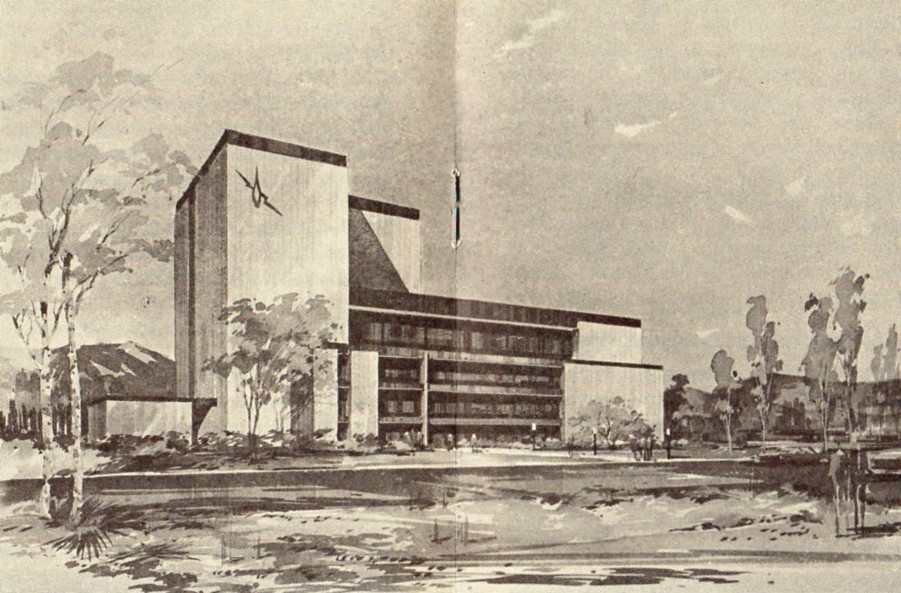
This rare artist's concept illustration of Fort St. Vrain comes from the October 1967 "News Briefs" brochure included in a Fort St. Vrain press package. This concept drawing is very close to the design actually built, which is shown in the artist's concept at the top of this article.
COMING SOON: Novel design of the prestressed concrete containment; design of the NSSS; construction photos on-site, and much more in future installments.

Farming within sight of the Fort St. Vrain Nuclear Generating Station; note tractor at far left of photo.

